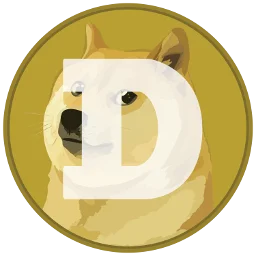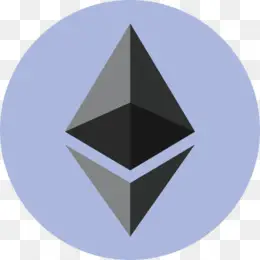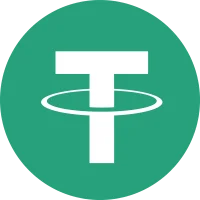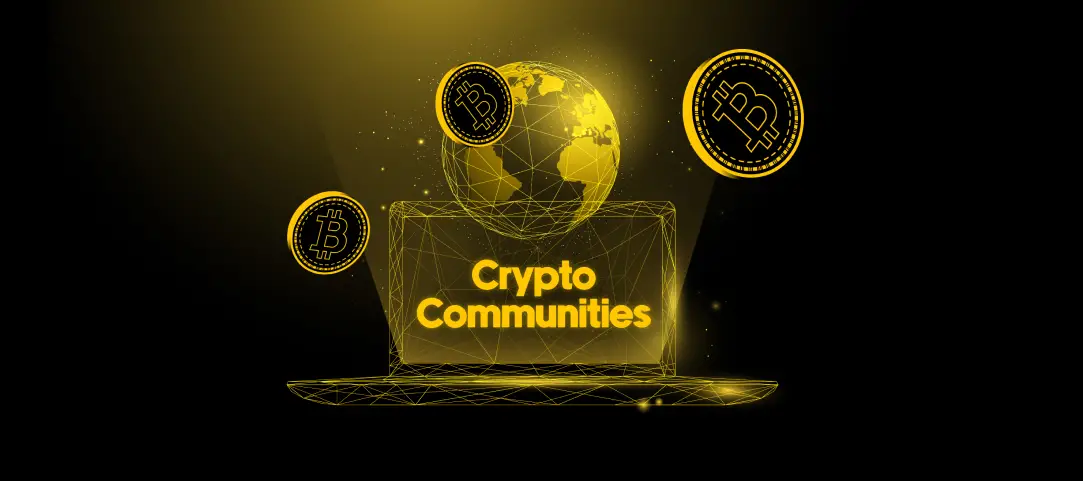Table of Contents
Community building is a marketing initiative in the Web2 landscape to increase customer engagement and loyalty for generating a high return on investment. However, most companies don’t focus on creating a sense of belonging for their customers who want to align with their brand and be a part of their journey. Web3 doesn’t operate this way, and communities take on a new form.
When it comes to communities in crypto, it’s more than a distribution channel for marketing purposes. It involves giving back power and control to users through governance, decentralized ownership, and incentives. Also, the open-source nature of blockchain technologies gives the community a chance to contribute in new ways and establish a positive feedback loop with the core team.
An engaged community is the heart and soul of a crypto project, with members deeply invested in time and money. We can also take it a step further and say crypto communities are one of the biggest drivers of new narratives in the markets. So, if you’re analyzing crypto projects, you should go beyond the fundamental market research and consider the size and strength of online communities.
But wait, how do you evaluate an online community spread across different platforms and understand its value-add to a crypto project? This article will give you the answer, plus three essential case studies of other communities that found tremendous success in the crypto space.
The Importance of Community When Marketing Crypto
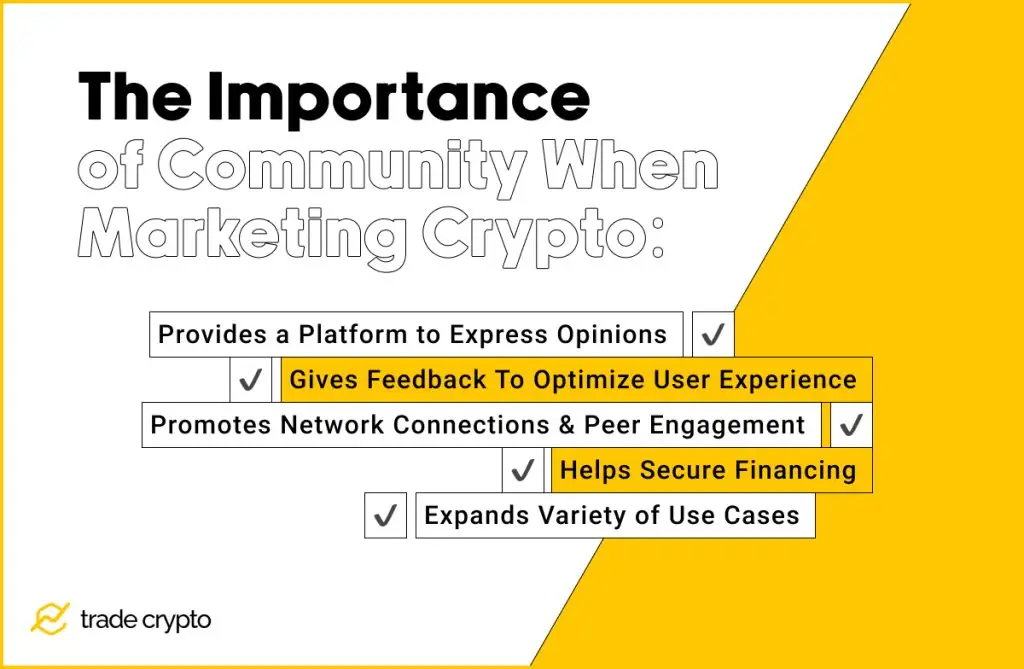
Before you evaluate a cryptocurrency’s lifespan based on community, you need to understand why it holds so much importance. Community members aren’t directly involved in project development, yet they are crucial to its success. Why is that so? Let’s see.
Provides a Platform to Express Opinions
When was the last time you made suggestions to a brand, and they took you seriously? Exactly!
In a Web2 environment, the power is concentrated in hands of a few who get to make all the decisions. This changes with Web3. In a crypto community, there is a constant dialogue between the teams and community members, where opinions expressed are treated equally.
When people want to see you voice your opinion, two things happen. One, the trust factor in the community strengthens. Two, you feel you have found your tribe where everyone is equally important. So, by bringing the community on the same page, projects improve community engagement and attract new community members.
Gives Feedback To Optimize User Experience
When project development is underway, it’s challenging to look through all the user pain points simultaneously, resulting in delays in important feature upgrades. In Web3, projects can leverage their communities to be the first group of testers to gain insightful feedback.
This open-feedback loop reduces the burden on developers, who previously didn’t have external assistance from a community. At the same time, community members get a chance to earn token rewards for giving feedback, like in the case of an incentivized testnet.
A great example of community aiding enhanced user experience is the LooksRare NFT marketplace. It quickly gained market share and competed with the likes of OpenSea because of its community-first approach. The team is openly discussing with users on Twitter what more features must be added to make the user experience frictionless.
Promotes Network Connections & Peer Engagement
As beneficial as a community is for projects, it can be equally satisfying for crypto community members. They can connect with other industry leaders in the crypto world and collaborate.
We saw similar things happen in the early days of the Bitcoin community. There were investors, technology enthusiasts, and true believers forming partnerships to build solutions for making Bitcoin accessible. So, participating in a crypto community can allow you to find connections and build something of your own.
Expands Variety of Use Cases
The majority of blockchain projects are open-source. So people having technical expertise can use the source code and build new applications. This helps grow the ecosystem and gives the community exposure to emerging projects.
For example, when the Ethereum blockchain launched its smart contract platform, it allowed the creation of decentralized applications. As Ethereum had a strong community, it automatically became the go-to platform for developers, giving birth to exciting use cases that go beyond finance, like gaming, music, and art.
Helps Secure Financing
Marketing in crypto also involves convincing community members to participate in crowdfunding. It is usually in the form of ICOs, IDOs, and IEOs, where projects offer to sell their native token at a discounted price before they are listed on exchanges.
Apart from raising capital cost-efficiently with no intermediaries, decentralized crowdfunding helps build passionate communities, giving projects much-needed support in the early stages. If you’re an investor, a community platform can also give you the latest updates on whether a team is making or not.
What Goes Behind Building a Strong Crypto Community
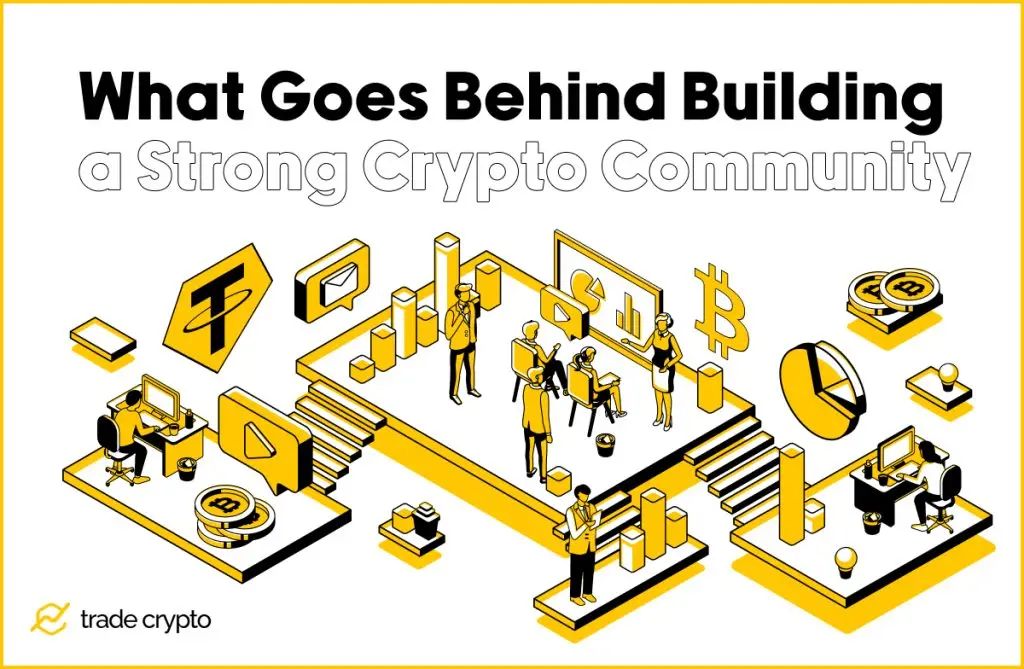
By “strong” community, we mean a community where people don’t constantly ask “when will the price moon” and truly see long-term value in the project. But building such communities with like-minded people requires a great deal of consistent effort.
For starters, the blockchain project has to install a community management system. It mainly involves streamlining the distribution of important information across all social media channels and community forums. Further, a crypto community manager prepares important documents to respond quickly to user queries.
While maintaining a fast response time is essential in retaining users, it doesn’t foster rapid growth. For that reason, many projects tap into incentive programs like airdrops and bounties, where users need to complete simple tasks and register their wallet addresses to receive the reward. This can be an expensive marketing initiative. But it’s worth it, as projects can rapidly grow their community from scratch.
Expanding internationally is also crucial for building a strong community. One way projects achieve this is by attending events. It can help teams to represent their brand globally and connect with potential investors and partners. In addition, crypto events are great for recruiting. Having someone native represent your brand in a foreign country will be more welcoming for people to join and participate in the blockchain community.
Another more practical way of reaching the target audience is onboarding the right influencers. For example, if a new gaming project is trying to grow its player base, it should have a Twitch streamer or a professional gamer represent the brand.
So far, we have discussed how important communities are to a project and what goes into creating a loyal community. Now it’s time to explore the social media platforms that host these communities and what makes each unique.
Popular Social Networks in Crypto
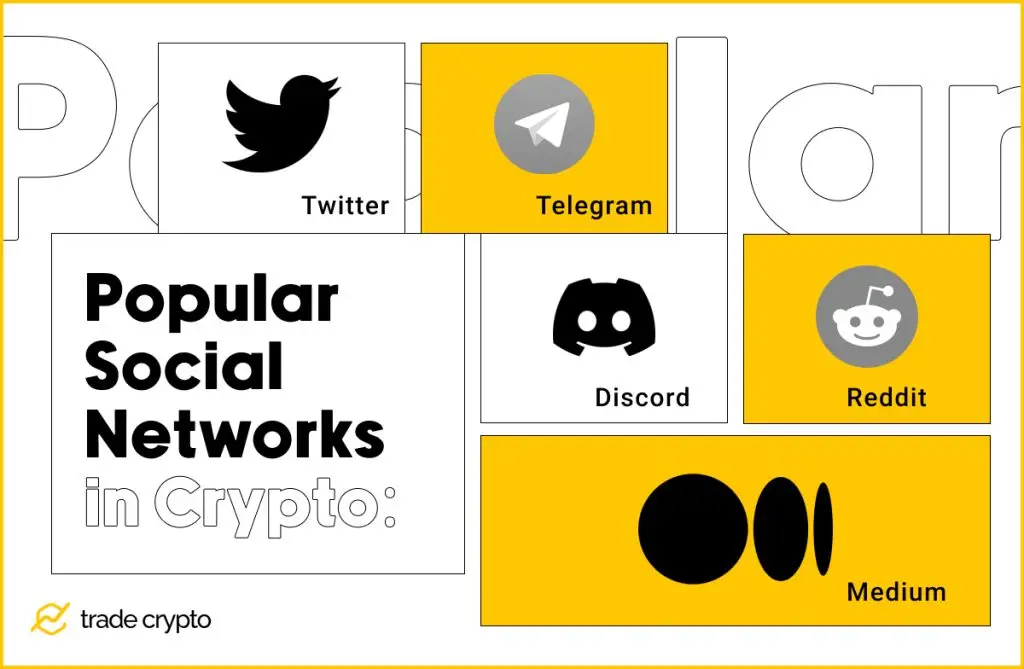
Crypto communities are active on five main social networks. Each one has a unique purpose and vibe to it. Let’s see what they are and how marketers use them to promote blockchain projects.
It is called “Crypto Twitter” for a reason. Twitter is one of the biggest marketing channels for crypto projects. It is a popular choice because it helps reach a wider audience in the industry. Everyone stays on Twitter and engages with the community, from crypto enthusiasts and developers to investors and founders.
Twitter also aligns with how the crypto industry works. It is spontaneous, and things change very quickly. If there’s an emergency and projects want to communicate with users, they tend to use Twitter first. Further, Twitter is also used for educating audiences and connecting with them deeper, thanks to Twitter Spaces.
Telegram
If Twitter is used for branding, Telegram helps projects with internal and external communication. Considering the fast-paced nature of Twitter, marketers use a platform like Telegram to address user concerns in a detailed manner. Telegram also allows community managers to create multiple groups for developers and normal users.
With over 700 million monthly active users, Telegram expands the scope of the target audience and facilitates projects to establish a global presence from the start. Telegram also has a built-in crypto bot powered by TON Network that makes buying, selling, and transferring cryptocurrencies seem effortless. So teams will likely continue to use Telegram to build an active community and manage internal discussions.
If there’s one thing crypto folk value, it is privacy. That’s why Reddit is essential for community building. People stay anonymous but actively contribute to the betterment of the community. Reddit’s organized content format also encourages newcomers to join crypto communities. It is not overwhelming because unnecessary information is filtered out while promoting specific niches with valuable knowledge. Some famous crypto Reddit communities are r/wallstreet, r/dogecoin, and r/bitcoin.
Reddit is also popping off in the NFT space. By partnering with Polygon, Reddit added support for NFT avatars and launched a marketplace. This move onboarded millions of new users to crypto while generating decent cash flow for Reddit. So, if you’re launching NFT collections, you must now think beyond Twitter.
Discord
Discord falls in the middle of most Web3 marketing funnels. The target audience first comes across a project on social media. And, if it has good community engagement, they tend to join the Discord server to learn more about the project. Discord allows projects to create multiple channels for communication.
Discord also helps community managers or moderators assign roles to community members based on colors, hierarchies, and channel permissions. This adds organizational structure to a project, making it easier for new members to find information and reach out for queries.
Medium
Medium is unlike any other social network we listed above. It is more suitable for sharing longer-form content such as technical deep dives, partner posts, and community recaps. As Medium has high domain authority, it helps with SEO practices.
So, if you have content distribution planned for Medium, your content can secure top Google rankings. As a result, you can grow your community organically at little to no cost. A good project always updates the community on Medium and shares insights at great length. This is another way for you to check how transparent a project is when sharing progress updates.
Tips for Analyzing Crypto Communities
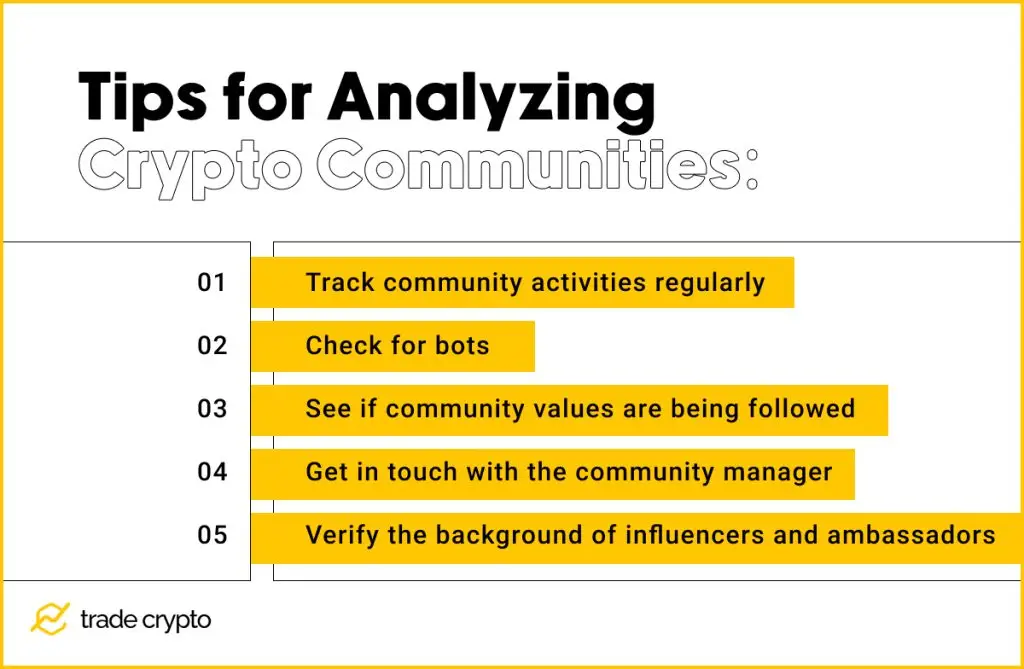
Social media numbers don’t give you the full picture of a crypto community. You have to look deeper to know the strength of the community. Also, you must check if any red flags give a cause to pause. We have highlighted five tips below to help you do both and understand the state of the community.
Track community activities regularly
Maintaining relevance is challenging in crypto. If projects are not consistently putting effort into engaging with community members and delivering on promises, they will lose users to the next hot trend. To turn community members into loyal fans, projects need to keep them in the loop of what’s happening behind the scenes and involve them in some capacity.
Check for bots
Having a massive following with high engagement rates is not enough. You have to check how that engagement is generated. In most cases, blockchain and NFT projects use bots to increase engagement and make it seem like they have an active audience.
So you have to filter followers of a project to check how many are genuine or spam. If it turns out that the majority of followers are fake, it is likely the team has done paid campaigns with third-party vendors. This is commonly done to create hype around the project before a product or token launch. The downside here is that the credibility of a project takes a hit. And social media platforms can even ban the account if they find any violations of their terms of service.
See if community values are being followed
A community can be divided by roles and responsibilities based on one’s expertise. But it cannot be divided by values. Everyone in a crypto community should uphold certain basic values to ultimately achieve whatever goals the project set out in the beginning
Community values also help a project stand out. With the right values and principles, a community can create a sense of exclusivity for members, and others remain as visitors. It is so important to check if community values are being followed or not because it defines the integrity of the project. If values are not followed, trust will be lost, and community engagement will go down.
Get in touch with the community manager
It can be hard to navigate if you have never been part of crypto communities before. So you should try and find community managers. They can help with technical support and clear any doubts you have about the project. Furthermore, a community manager can help you see how community building aligns with business strategy and development.
Verify the background of influencers and ambassadors
There’s nothing wrong with leveraging the power of influencers to grow a community. People tend to relate more when they see a familiar face promoting a product or service, so it’s all well and good to use influencers for marketing crypto. But you need to check if the influencer has any shady past.
We see it repeatedly in crypto that influencers promote pump-and-dump schemes of altcoins and NFTs. The impact can be huge when the audience or subscriber base is in the millions. These influencers usually announce fake giveaways for engagement, compel buyers to tokens, and use them as exit liquidity.
You should avoid projects that use such influencer tactics to promote their tokens. A few notable influencers who got caught promoting crypto scams are Kim Kardashian, Floyd Mayweather, Adin Ross, and Jake Paul. You should also look out for scammers using well-known personalities to promote their fake coins. The most recent example is trading scams using Richard Branson’s image.
Examples of a Great Community
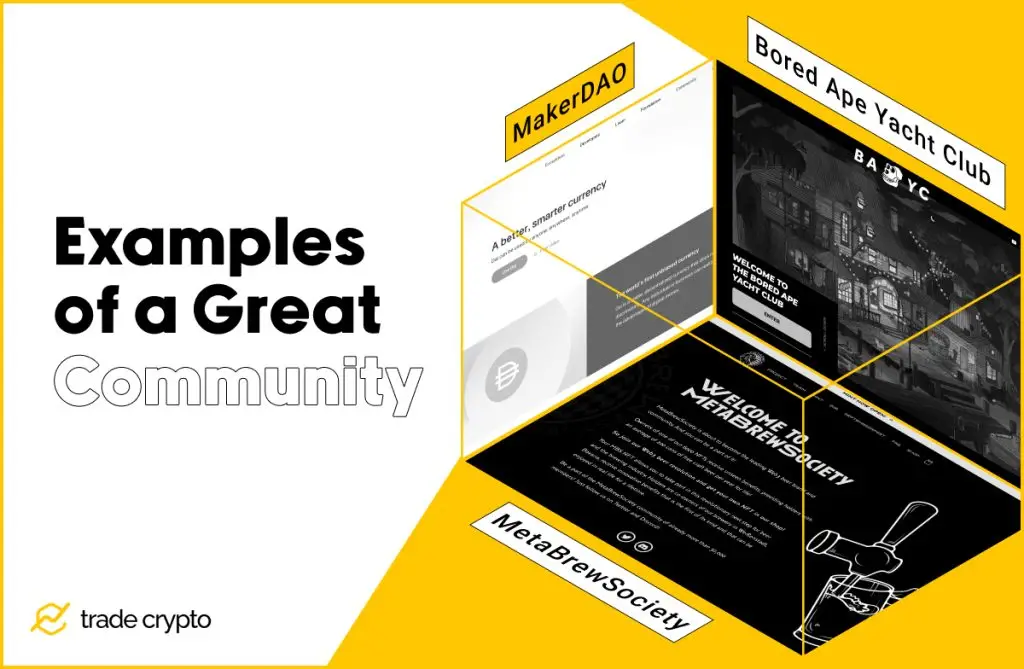
Bored Ape Yacht Club
For an outsider, it can be hard to grasp how monkey pictures are worth hundreds of thousands of dollars. And why someone is willing to pay millions for the same NFT with few extra traits. This is where people miss out on the community aspect. Yes, Bored Ape Yacht Club is an NFT collection. But what it represents is so much more.
Within a few months after its launch in 2021, BAYC started a culture shift in Web3. The project’s early adopters continuously raised awareness in their networks and onboarded dozens of celebrities, entrepreneurs, rappers, and sports stars. This was also not promotional because everyone loved joining the exclusive community. And also flex on social media by using the NFT as a profile picture. A few notable names are Gary Vee, Stephen Curry, Eminem, Neymar, and Mark Cuban.
BAYC managed to create 10,000 true fans by giving back to the community. Releasing new collections with MAYC and BAKC allowed new members to join the community. And, at the same time, reward holders of the original BAYC NFTs. Further, the release of the APE token decentralized the entire project, creating a DAO and giving governance power to holders.
Besides rewarding the community, BAYC has also organized fantastic events online and offline to keep the community engaged. With the annual Ape Fest, BAYC throws incredible parties for community members to get to know each other and build long-lasting bonds. This is why the creators of BAYC, Yuga Labs, managed to raise $450 million at a $4 billion valuation. It is the strength of the community that made all the difference.
MakerDAO
MakerDAO is the gold standard in the DAO landscape for leading community-driven decentralized organizations. From the get-go, MakerDAO declined to follow traditional approaches to building a community. They didn’t do an ICO to raise money. Instead, they sold tokens privately to selected investors. This ensured everyone was on the same page and had the same long-term belief in the project.
Further, the DAO platform encourages members to participate in critical discussions on its forum. Since its launch, there have been nearly 30,000 posts written by members on the Maker Forum. This indicates community members are actively expressing their opinions. And we can see that the DAO is implementing necessary changes through Maker Improvement Protocols (MIPS).
MakerDAO also enabled other communities in the space to leverage their stablecoin infrastructure. This helped add more functionality to the DAI coin and increased the DeFi lending ecosystem.
MetaBrewSociety
Do you want free beer for life? If it’s yes, you will love the MetaBrewSociety community. The MBS is an emerging NFT project offering 240 cans of free Bavarian beer per year, among other benefits to all NFT holders.
Owners of MBS NFTs also get VIP tours of the breweries for beer tasting and meeting other members of the community. Another real-life utility is that you can redeem discounts at MBS shops for beers, food, and clothing.
If lifetime beer and discounts on essential time aren’t enough, the team is giving back 20% of the revenue generated to the NFT holders. You can simply sign up for the affiliate program and make money on every customer you refer to MBS.
In addition to revenue share, MBS gives voting rights to owners to decide the next location of the MBS beer shop and other business decisions. MBS also understands the importance of simplifying Web3 and expanding the community to non-crypto natives. That’s why they made it easier for anyone to mint MBS NFTs using a simple credit card compared to software wallets.
A special mention goes to the community of PoolTogether, a no-loss lottery platform. When it was hit with a class action lawsuit, the community came together and provided the funds to fight the legal battle. A total sum of $1.4 million was collected through an NFT sale to cover lawsuit fees. This shows how strong communities can go to any lengths to support their favorite project.
Closing Thoughts
Web3 ethos revolves around communities. And that’s not going to change anytime soon. So, if you are evaluating crypto projects, you have to factor in the engagement and loyalty of the community. To do this, you must look past the social media hype and get involved in Discord servers and forum discussions. You should try to find what gives a community an edge over others and monitor reactions when things are not going well. This will help you distinguish long-term believers and short-term price watchers.
Crypto Ping Pong Digest
Trash style news. You will definitely like






